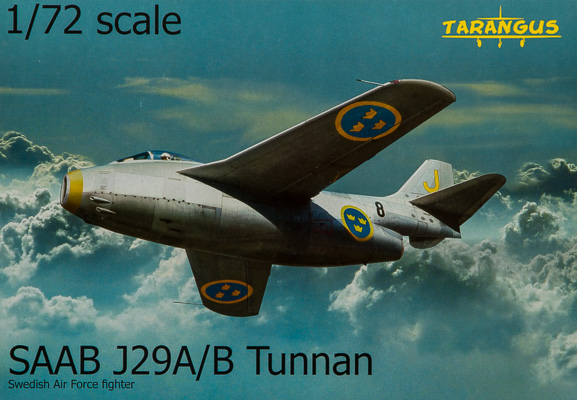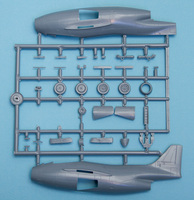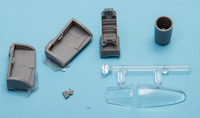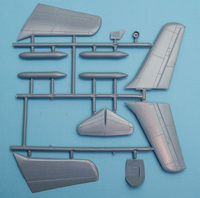
Tarangus 1/72 Saab J29A/B Tunnan
By Chris Banyai-Riepl
Overview
The Saab J29 Tunnan was Sweden's second indigenous jet fighter, following the J21R. Belying its appearance, the J29 was both fast and maneuverable, taking advantage of German research on swept-wing design. The first prototype took to the air on September 1, 1948, and by 1956, over 650 were built. The aircraft served in Swedish service until the mid-1970s, and the J29 was exported to Austria, where it operated from 1961 to 1972.
The J29 was also the first Swedish jet aircraft to see combat when five aircraft deployed to the Republic of Congo in 1961 as part of a United Nations peacekeeping mission. Six more Tunnans joined the original five in 1962, including two S29C reconnaissance aircraft. The missions flown by the J29 consisted of ground support, utilizing their internal cannons and unguided rockets. No Tunnans were lost in action, which is surprising given the heavy ground fire they encountered.
Since retirement, several J29 Tunnan aircraft managed to avoid the scrapper's torch, and two dozen can be found around the world today. Most are in Sweden and Austria, but examples can also be found in Italy, Great Britain, and the United States, and one example is currently restored to flying status as SE-DXB.
The Kit
 A long-time fan of Swedish aviation, I have always liked the J29 Tunnan. Over the years I have collected a fair number of Heller kits, and one or two Matchbox kits, but both of those kits are quite old and need a fair bit of work to bring them up to today's quality. The latest kit from Tarangus aims to fill that need, and their latest kit provides the first J29A/B kit in 1/72 scale. This is a great balance to the Heller kit, which has the later dogtooth wing for a J29E, and the Matchbox kit, which is a J29F with the bigger, afterburning Ghost engine and Sidewinder capability. Molded in dark gray plastic that resembles Sword kits (most likely who tooled this kit), the Tarangus kit features finely recessed panel lines, some resin details, and a nice decal sheet with markings for three options.
A long-time fan of Swedish aviation, I have always liked the J29 Tunnan. Over the years I have collected a fair number of Heller kits, and one or two Matchbox kits, but both of those kits are quite old and need a fair bit of work to bring them up to today's quality. The latest kit from Tarangus aims to fill that need, and their latest kit provides the first J29A/B kit in 1/72 scale. This is a great balance to the Heller kit, which has the later dogtooth wing for a J29E, and the Matchbox kit, which is a J29F with the bigger, afterburning Ghost engine and Sidewinder capability. Molded in dark gray plastic that resembles Sword kits (most likely who tooled this kit), the Tarangus kit features finely recessed panel lines, some resin details, and a nice decal sheet with markings for three options.
 The construction starts with the interior, and this is a nice mix of resin and plastic. The instrument panel and cockpit tub are plastic, while the seat is resin. There is sufficient detail in the kit for an out of the box build, but for those who really want to go nuts, there is a photoetch set out by Maestro Models that adds that extra little bit. Once the interior is together, the fuselage can go together, and here you'll add resin main wheel wells, a plastic nose wheel well, and a combination resin/plastic intake assembly. There is also an exhaust pipe, and the instructions wisely recommend adding weight to keep this one on all three wheels.
The construction starts with the interior, and this is a nice mix of resin and plastic. The instrument panel and cockpit tub are plastic, while the seat is resin. There is sufficient detail in the kit for an out of the box build, but for those who really want to go nuts, there is a photoetch set out by Maestro Models that adds that extra little bit. Once the interior is together, the fuselage can go together, and here you'll add resin main wheel wells, a plastic nose wheel well, and a combination resin/plastic intake assembly. There is also an exhaust pipe, and the instructions wisely recommend adding weight to keep this one on all three wheels.
 With the fuselage together, the rest of the assembly is fairly straightforward. The wings are split into upper and lower halves, with positive tabs for the attachment point. The wingtip pitot tubes are separate as well, so there's no worry about breaking these off during construction. The horizontal stabilizer is a solid single piece that slips around the vertical fin, while the fuselage gets added details that include the gun bulges on the nose and the tail skid.
With the fuselage together, the rest of the assembly is fairly straightforward. The wings are split into upper and lower halves, with positive tabs for the attachment point. The wingtip pitot tubes are separate as well, so there's no worry about breaking these off during construction. The horizontal stabilizer is a solid single piece that slips around the vertical fin, while the fuselage gets added details that include the gun bulges on the nose and the tail skid.
For the landing gear, this is simple, yet sturdy. The nose gear is molded as one piece, including the nose wheel. This will make painting a bit of a challenge, but the added durability will be worth it as this can be a big weak spot. The main gear is much more robust, with sturdy struts and separate wheels. The wheels are split into halves, so take care to keep those in alignment when you put those together. The wheel doors have good interior detailing, both for the main gear and nose gear doors. Finally, the kit comes with the oddly shaped underwing fuel tanks, and they do a great job of capturing that unique shape.
 The decal choices are all for Swedish J29s, all of which are finished in overall natural metal. The first choice is "Yellow J" from F8 and features a yellow band around the nose. The second choice is "White G" from F22 and features the large white squares with UN on them for operations in the Congo. The final choice is "Red M" from F13 based in Norrköping. This last scheme has large black bands around the fuselage and wings, along with fluorescent wingtips. The decals are nicely printed and includes plenty of stenciling.
The decal choices are all for Swedish J29s, all of which are finished in overall natural metal. The first choice is "Yellow J" from F8 and features a yellow band around the nose. The second choice is "White G" from F22 and features the large white squares with UN on them for operations in the Congo. The final choice is "Red M" from F13 based in Norrköping. This last scheme has large black bands around the fuselage and wings, along with fluorescent wingtips. The decals are nicely printed and includes plenty of stenciling.
Conclusion
This is an exciting new kit, and one that I've been looking forward to for many years now. It is a short-run kit, so it does have some flash around the edges, but if you are ready for that, building this won't be too challenging. My thanks to Tarangus for the review sample.
